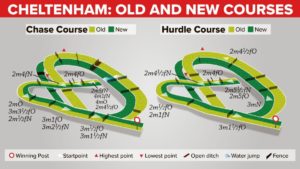 Prestbury Park, Cheltenham is home to three separate racecourses but, with the exception of the Glenfarclas Cross Country Chase, which is run on its own specialist course, all the races at the Cheltenham Festival are run on the Old Course or the New Course. Both courses are left-handed, undulating and galloping in character, with stiff fences and a taxing uphill finish, but there are some significant differences between them, which may not be immediately obvious to the casual observer.
Prestbury Park, Cheltenham is home to three separate racecourses but, with the exception of the Glenfarclas Cross Country Chase, which is run on its own specialist course, all the races at the Cheltenham Festival are run on the Old Course or the New Course. Both courses are left-handed, undulating and galloping in character, with stiff fences and a taxing uphill finish, but there are some significant differences between them, which may not be immediately obvious to the casual observer.
Old Course
The Old Course is used, with the aforementioned exception, for all the races on Day One and Day Two of the Cheltenham Festival, which include the Champion Hurdle, Champion Bumper, and Queen Mother Champion Chase. The Old Course is an oval, approximately a mile and a half in circumference, with nine fences to a circuit, just one of which is in the home straight. It is, in fact, just half a furlong, or 110 yards, shorter than the New Course, but is, without doubt, the tighter and sharper of the two.
From its highest point, which is also the furthest from the stands, the Old Course takes a direct route to the winning post, typically favouring horses that race prominently, travel within themselves and have a turn of foot. Horses do, of course, tie up on the run-in, but the lead changes less often in the closing stages than might be expected. On the steeplechase course, the second-last fence, which was originally positioned before the final turn, was moved into the home straight in 2010 and has since been moved further past the bend, on more than one occasion, in recent years, but remains notoriously tricky.
New Course
The New Course – which, incidentally, was first used in its current guise in 1967, so is only relatively new – is used for all the races on Day Three and Day Four of the Cheltenham Festival, which include the Stayers’ Hurdle and Cheltenham Gold Cup. The New Course is slightly longer than the Old Course, with ten fences to a circuit, two of which are in the home straight.
The New Course runs alongside the Old Course for much of the way but, from its highest point, takes a parallel, but wider, route to the winning post. Consequently, the emphasis is more on stamina and hold-up horses, who may need to be manoeuvred into a position to improve, have a little more time to make ground from off the pace. On the hurdle course, which features just two flights in the final seven furlongs, the tendency is for horses to start racing too far from home, which, once again, plays into the hands of those ridden with more restraint. On the steeplechase course, the position of the fourth-last fence, at which Kauto Star came to grief in the Cheltenham Gold Cup in 2010, has been adjusted in recent years to reduce the number of fallers at the obstacle. Nowadays, like the second-last on the Old Course, it is a portable fence, which affords the Clerk of the Course the flexibility to move its position, if necessary.
